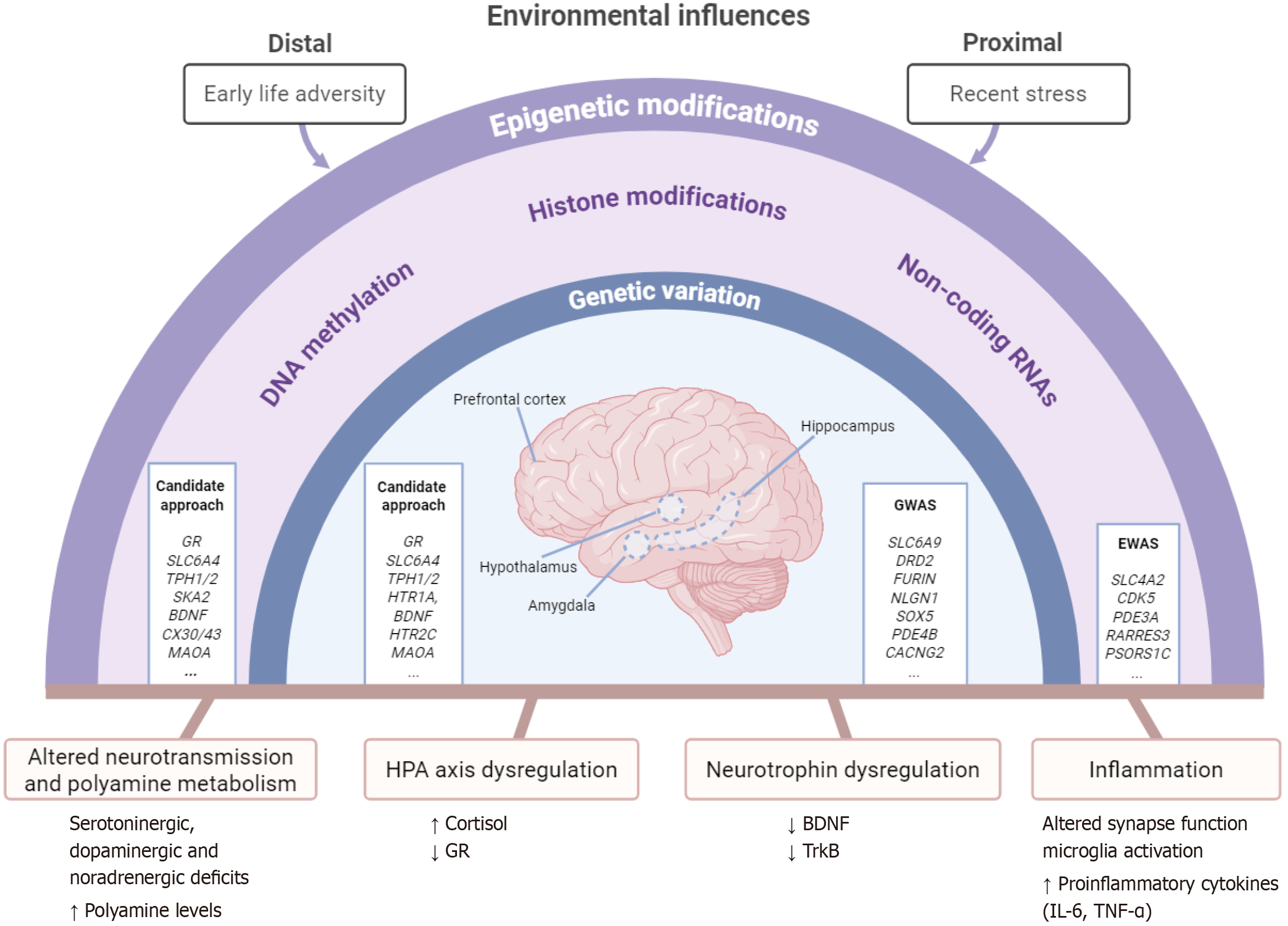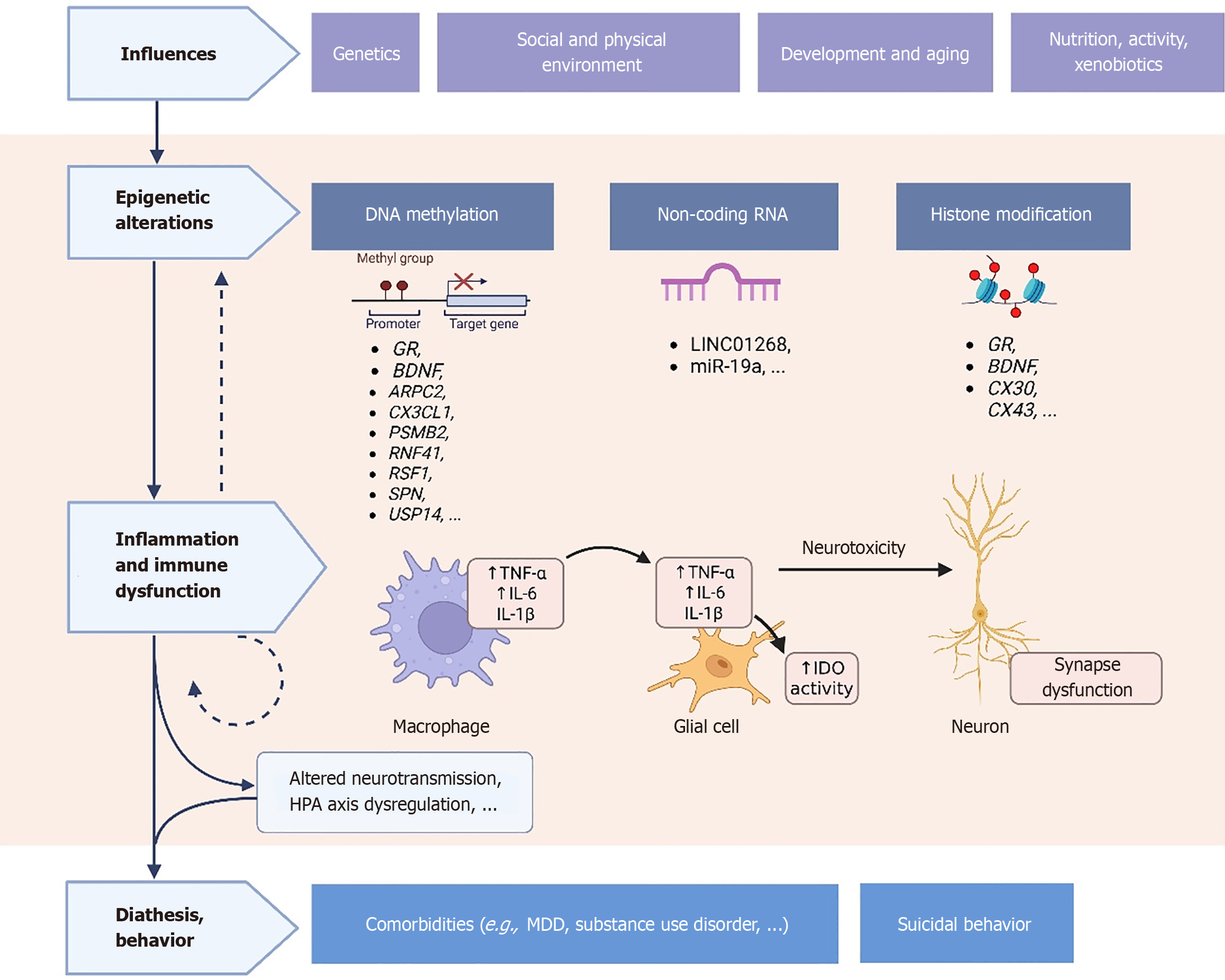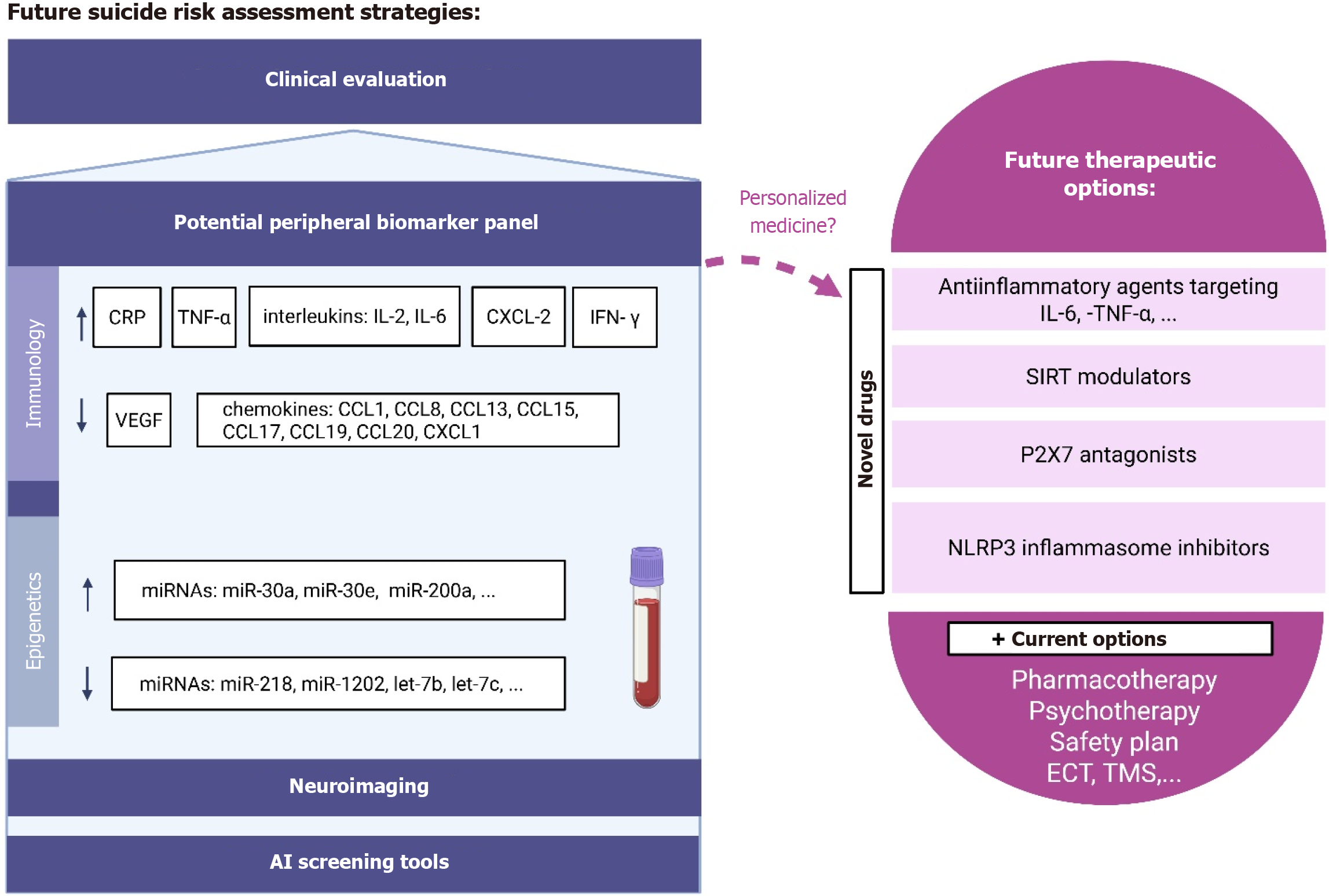Copyright
©The Author(s) 2025.
World J Psychiatry. Sep 19, 2025; 15(9): 107726
Published online Sep 19, 2025. doi: 10.5498/wjp.v15.i9.107726
Published online Sep 19, 2025. doi: 10.5498/wjp.v15.i9.107726
Figure 1 Genetic, epigenetic and environmental factors influence the pathophysiology of suicidality.
Brain areas most commonly examined in postmortem suicidality research are labeled in the center of the image. Some of the genes associated with suicidality via targeted and (epi)genome-wide approaches are listed in the boxes to the left and right of the center. In the upper part of the image, environmental influences that act distally or proximally to alter suicide risk are represented. The interaction between the environment, genetic predisposition and epigenetic mechanisms drives the development of molecular and functional alterations associated with suicidality, including the disruption of key neurobiological processes like neurotransmission, neurotrophin signaling, stress and inflammatory responses (presented in the bottom of the image). GWAS: Genome-wide association study; EWAS: Epigenome-wide association study; HPA: Hypothalamic-pituitary-adrenal; GR: Glucocorticoid receptor; TrkB: Tropomyosin receptor kinase B; BDNF: Brain-derived neurotrophic factor; IL-6: Interleukin 6; TNF-α: Tumor necrosis factor alpha; SLC6A4: Solute carrier family 6 member 4; SLC4A2: Solute carrier family 4 member 2; SLC6A9: Solute carrier family 6 member 9; TPH1/2: Tryptophan hydroxylase 1/2; SKA2: Spindle and kinetochore associated complex subunit 2; CX30/43: Connexin 30/43; MAOA: Monoamine oxidase A; HTR1A: Serotonin 1A receptor; HTR2C: Serotonin 2C receptor; DRD2: Dopamine receptor 2; FURIN: Paired basic amino acid cleaving enzyme; NLGN1: Neuroligin-1; SOX5: SRY-box transcription factor 5; PDE4B: Phosphodiesterase 4B; CACNG2: Calcium voltage-gated channel auxiliary subunit gamma 2; CDK5: Cyclin-dependent kinase 5; PDE3A: Phosphodiesterase 3A; RARRES3: Retinoic acid receptor responder 3; PSORS1C: Psoriasis susceptibility 1 candidate 1. Created in BioRender. Šmon J. (2025) https://BioRender.com/kzls5et.
Figure 2 Schematic diagram: Interactions between epigenetics and the immune system in suicidality.
This conceptual diagram, based on the synthesis of current literature, illustrates how various exogenous and endogenous factors influence the epigenetic state that contributes to suicide diathesis and suicidality itself. Epigenetic mechanisms regulate the expression of genes that are directly or, more commonly, indirectly involved in the immunity of peripheral and central tissues, which can also communicate with one another (e.g., macrophage - glial cell interactions). As represented by the figure below the “DNA methylation” box, DNA methylation in promoter regions is associated with the repression of transcription. Genes and RNAs listed below the three epigenetic mechanisms (DNA methylation, non-coding RNAs and histone modifications) have been implicated in various methodologically different studies, including those with epigenome-wide approaches. In suicidality, epigenetic alterations may promote glial dysfunction and cytokine dysregulation, which has wide-reaching effects, impacting neuron function, neurotransmission and hypothalamic-pituitary-adrenal axis. Inflammatory processes may exacerbate each other (represented by the dashed circle) and contribute to the biological correlate of suicide diathesis, promoting the development of psychiatric disorders and influencing behavior. As represented by the dashed line, the immune system can also affect epigenetics, providing potential for both regulation and exacerbation. GR: Glucocorticoid receptor; BDNF: Brain-derived neurotrophic factor; ARPC2: Actin-related protein 2/3 complex subunit 2; CX3CL1: Chemokine (C-X3-C motif) ligand 1; PSMB2: Proteasome 20S subunit beta 2; RNF41: Ring finger protein 41; SPN: Sialophorin; USP14: Ubiquitin specific peptidase 14; IL: Interleukin; TNF-α: Tumor necrosis factor alpha; IDO: Indoleamine 2:3-dioxygenase; CX30: Connexin 30; CX43: Connexin 43; HPA: Hypothalamic-pituitary-adrenal; MDD: Major depressive disorder. Created in BioRender. Šmon J. (2025) https://BioRender.com/bdjmxj3.
Figure 3 The role of biomarkers in suicide risk assessment and future therapeutics.
This conceptual illustration, based on the synthesis of recent literature, demonstrates the possible future directions for suicide risk assessment and personalized treatment strategies. On the left side, a potential future suicide risk assessment strategy is presented, in which various tools (peripheral blood biomarkers, neuroimaging, artificial intelligence technology) may aid the clinician in evaluating suicide risk. Increased or decreased levels of some of the potential immunological (interleukins, chemokines, etc.) and epigenetic biomarkers, are listed, based on reported associations in suicidality and depression. On the right side, possible future therapeutic options are presented for suicide risk alleviation and/or the treatment of underlying psychiatric disorders, that may be used in combination with established treatment options. Immune modulators and anti-inflammatory agents are listed, but not epigenetic modifiers, as there is stronger implication for the clinical implementation of the former. Blood-based biomarker measurement in peripheral blood, e.g., via enzyme-linked immunosorbent assay or multi-marker panels, could contribute to individualized risk profiling and thus enable personalized therapy. AI: Artificial intelligence; CRP: C-reactive protein; TNF-α: Tumor necrosis factor alpha; VEGF: Vascular endothelial growth factor; IL: Interleukin; CCL: Chemokine C-C motif ligand; CXCL: Chemokine (C-X-C motif) ligand; ELISA: Enzyme-linked immunosorbent assay; IFN-γ: Interferon gamma; SIRT: Sirtuin; P2X7: Purinoceptor 7; NLRP3: NLR family pyrin domain containing 3; ECT: Electroconvulsive therapy; TMS: Transcranial magnetic stimulation. Created in BioRender. Šmon J. (2025) https://BioRender.com/jm04fz5.
- Citation: Kouter K, Šmon J, Videtič Paska A. Epigenetics and immunology: Under-recognized aspects of suicidality. World J Psychiatry 2025; 15(9): 107726
- URL: https://www.wjgnet.com/2220-3206/full/v15/i9/107726.htm
- DOI: https://dx.doi.org/10.5498/wjp.v15.i9.107726











